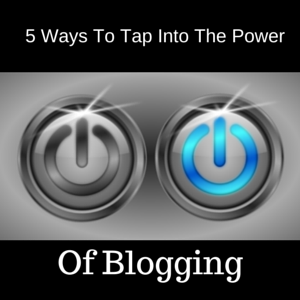
What is your least favorite experience as a blogger? Maybe that least favorite experience is staring at the computer screen, struggling to think of what you will write your next blog post about. When I was new to blogging, this was not only my least favorite experience, but it was also too common.
Knowing that you have to write more blog posts but not being able to come up with the ideas is a frustrating point in the writing process. The number of times this frustration occurs and lasts is dependent on the actions we take to reduce the number of times this frustration occurs and create a better response to it. Here are 10 methods you can use to come up with more blog post ideas and respond better to writer’s block, therefore reducing your frustrations as a blogger at the same time.
#1: Look At What Other Experts In Your Niche Wrote About On Their Blogs
The internet gave us the power to access any type of information we want at a lightning fast speed. The days of driving (or walking) to the library to gather more information have come to an end.
However, few people utilize the information on the web to come up with more blog post ideas. Many people use the web to surf YouTube videos, conduct research for the school essay, or browse through Facebook.
In my opinion, one of the most underrated ways of using the web is to come up with more blog post ideas. I read the blogs of various people in my niche. Doing so allows me to learn more information about my niche, and some of the methods I read about in their blog posts spark ideas for the blog posts that I write. I will never advocate plagiarism for as long as I live (and I have been plagiarized, so I know what it feels like), but if you combine some ideas from other blog posts with your knowledge and unique content, you will come across more blog post ideas while writing unique content.
#2: Take Two (Or More)!
As you write more blog posts, you will start to get an idea of which of your blog posts are the most successful. Sometimes, a blog post emerges as a winner out of pure luck while at other times, your most successful blog posts all relate to one specific topic.
Regardless of what your most successful blog posts are, that is, the ones that gets the most traffic, those blog posts can strategically be used to keep people on your blog for a longer period of time. You can write a Part Two for one of your blog post that is already popular. Since the original blog post is popular, the Part Two will also get more attention. Think along the lines of The Dark Knight. The first movie was spectacular, so people came back and watched the second movie. Then, people liked the second movie and decided to watch the third one. If there is a fourth movie, I am sure it would get a big crowd.
After you write your Part Two blog post, promote that blog post at the bottom of the original blog post. At the end of Part Two, mention Part One. If you create a Part Three, promote the earlier parts at the end of that blog post. Part Two promotes one and three while Part One promotes two and three. Visitors who want to read through all three parts of that series will have to click all three links and read the content. Therefore, the visitors who read that one series will stay on your blog for a longer period of time. A creative idea would be to create an entire blog based on a series of blog posts. Groove HQ does this very well.
#3: Change The Title Of A Past Blog Post
The idea for your next blog post could be in a blog post that you already wrote. When I am stumped and struggling to think of new blog post ideas, I look at all of my past blog posts’ titles. The first reason I look back at all of these titles is because looking back has its set of rewards. The second reason I look back at all of these blog posts is because I can simply replace 1-2 words in a blog post title, add a word, or subtract a word, and then I would come up with a completely new blog idea.
Let’s say you have a blog post called “10 Ways To Get More Twitter Followers.” There are plenty of variations that can be applied to this one title:
- “25 Ways To Get More Twitter Followers”
- “10 Tips To Get More Pinterest Followers”
- “10 Ways To Get More Blog Subscribers”
- “10 Ways To Lose Twitter Followers”
“10 Ways To Get More Twitter Followers” is one of my core building blocks for blog post ideas. I simply change the wording of the title in a way that would change the blog post’s topic, and then I start writing that blog post. As you create more core building blocks, it gets easier to build on top of them. Another core building block I have is, “10 Twitter Mistakes You Should Avoid.” I can replace, add, or remove words in order to come up with a completely new blog post idea.
#4: Use Topsy
Topsy allows you to see any tweet on Twitter, and the tool does a nice job at organizing those tweets based on categories. You can search a niche-based keyword in Topsy, and then a series of tweets containing that keyword will show up. Some of those tweets can inspire new blog post ideas. Some of the tweets you read on Topsy may even become core building blocks for blog post ideas. Twitter’s search engine also works fine, but it is easier with Topsy’s search engine to get very specific (video content, tweet with a link, tweet without a link, etc).
#5: Create A Twitter List Of Influential People In Your Niche
Although Topsy is more specific than Twitter’s search engine, Twitter has a special, unique feature that still makes it a very valuable resource for coming up with more blog post ideas. Twitter allows you to create a list of users that display as your custom feed.
Let’s say you decided to put 20 people on your Twitter list. The only tweets that would appear on the custom feed would be from those 20 people, regardless of how many people you are following. You can create a custom list that consists of the leaders of your niche. Then, you can scroll through their tweets. One of those tweets could provide the sparks for your next blog post idea.
#6: See What People Are Asking On Yahoo! Answers
Getting customers to ask you questions and turning those questions into blog post ideas is one of the smartest way to write blog posts. You get to answer your customers’ questions while putting content on your blog that answers the same questions other people may have (but these people were either too afraid to ask or couldn’t communicate with you). If you can take this path with surveys, and you get enough questions in the comment section, then focus on that path instead of Yahoo! Answers. Regardless of how popular you are, it wouldn’t hurt to have some surveys on your blog and encourage visitors to ask questions.
However, most bloggers do not get enough traffic to be getting dozens of questions every day from survey responses, comments, or any other method. Most bloggers only get a few questions every month at the very most. For the bloggers who do not get as many customer questions, there is still a reliable place to see what questions your customers may have.
Yahoo! Answers is that solution. You can search niche-related keywords on Yahoo! Answers to see what types of questions your potential customers and visitors are asking. Then, write blog posts that answer the questions you saw on Yahoo! Answers. You can also answer some of the questions directly on Yahoo! Answers and promote your blog. Yahoo! Answers is one of the most visited websites on the entire web, and it would be good to have a backlink to your blog there.
#7: Look Through The Comments Of Popular Niche-Related Blog Posts
Looking through the comments of popular, niche-related blog posts on the web and your blog may expose some of the questions that your customers have. You may know the answers to the questions people are asking in the comments section.
The first thing you should do is answer that person’s question in the comments section. It is okay to answer someone’s question on another person’s blog. Some bloggers will be okay with it (some may even thank you for taking the time to write the answer) while others may decide to not publish your answer and then come up with their own response (this does not happen as often, and it’s bad ethic). Regardless of whether the comment gets published or not, you are making an attempt to serve the person who commented on that blog post. Serving others is one of the core values of successful entrepreneurs.
[tweetthis url=”http://bit.ly/1D41Qot”]Serving others is one of the core values of successful entrepreneurs.[/tweetthis]
The second thing you should do is write a blog post that answers the question. If one person had a question, chances are that other people have the same question. If you answer a question for one person and publish that answer in the form of a blog post, then you are answering the same question that people from around the world had (until they read your blog post and the answer to the question).
#8: Read Books
Reading books is a valuable way to come up with more blog post ideas and obtain more knowledge. Some of the books I have read have completely changed my business habits and the way I structure my time and goals. You may be so empowered by one of the books you read that you may come up with dozens of blog post ideas just from that one book. I know that multiple blog posts I have written are based on what I read in The 12 Week Year, The ONE Thing, and multiple books written by Seth Godin.
#9: Watch YouTube Videos
YouTube videos are another great source of knowledge. However, what you learn on YouTube depends on which YouTube videos you watch. The only way you are learning new things about your niche on YouTube is if you are watching niche-related videos. If you are a digital marketing expert watching YouTube videos about comedy or an upcoming video game (at some times…guilty as charged), then you are not learning anything new about your niche.
There comes a time and place to watch anything you want on YouTube, but that should not be a daily habit. My recommendation is to surf YouTube for as long as you want for just one day every month. If you use YouTube every day, chances are you will watch several re-runs of the same video. Your time is more valuable than that.
#10: Write Multiple Blog Post Ideas For One Topic
If you write blog posts about Twitter, then you can write multiple blog posts that revolve around that one topic. For this tip, let’s go back to the core building block, “10 Ways To Get More Twitter Followers.”
In one of the tips, you may encourage your visitors to have more conversations with their followers. Therefore, you can write a blog post called, “10 Ways To Have More Conversations With Your Twitter Followers.”
You can also gain more followers by getting more retweets. Therefore, you can write a blog post called, “10 Ways To Get More Retweets On Twitter.” One of the ways to get more retweets on Twitter is by tweeting pictures. Then, you can write a blog post called, “The 10 Elements Of Highly Retweeted Pictures.”
One of the tips you could mention in that article is that creating your own stunning pictures works well. People may not know how to create their own pictures in the first place, so you may want to write a blog post called, “10 Tools For Creating Free Pictures On The Web.”
Do you see how one blog post about getting more Twitter followers turned into four other ideas? I could have gone on with this example in an infinite loop, but that would take too long.
In Conclusion
One of the common reasons why bloggers get frustrated is simply because they can’t think of any ideas for the next blog post. When a blogger is able to write content, that blogger is in a type of paradise for that moment of time. The moment writer’s block steps in, it becomes nearly impossible to think of new ideas. As a result, that paradise is lost and replaced by frustration. By implementing these tips, you will know how to come up with more blog posts ideas so that frustration occurs less often.
Which tip was your favorite? Do you have another tip to make it easier for us to think of more blog post ideas? Please share your thoughts and advice below.




